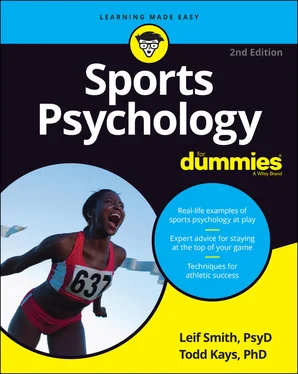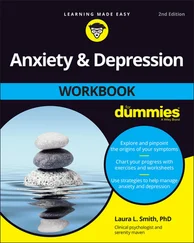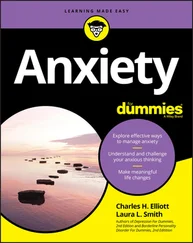Describe the time and place you were competing. Remember it as vividly as possible, as if you are there, competing, right now.
Describe what made this one of your best performances. Remember that you may not have won the game or the ideal mindset may have only been present for a small time during your game or competition. Some examples might be batting 4 for 4 at the plate, scoring a career high in points, shooting your lowest score in golf, or beating a top-ranked opponent.
Just as you did previously, answer these prompts: Behaviors : Were you smiling, laughing, cheering on teammates, communicating, or bouncing back after a mistake? Thoughts : What were you thinking about? Maybe nothing? Something simple like, “this play” or “breathe” or “be here now?” Emotions : What did you experience emotionally? Calm? Excitement? Lightness? Ease? Confidence? Body : What do you notice about your body? Were your muscles tense or loose? Was your heart rate fast or slow or moderate? Was your breathing short and shallow or easy, deep, and comfortable?
Identify important information by writing in your journal. (Remember: Every athlete should have a performance journal — those who use a journal effectively and consistently get better quicker.) It can be a small journal that you can keep in your athletic bag, but just make it a durable one, as we all know how we toss around our athletic bags. This journal should go with you everywhere.
Journal continuously and consistently each time you have a great performance. You want to key in with specifics and be clear about what exactly was happening during your performance.
Spend time visualizing and burning these performance details into your brain. Read Chapter 7, on imagery, to learn more about how to do this like the pros.
Continue to re-read some of your entries in this journal as a mental training drill from time to time. Remember, if you do not practice your physical skills (for example, your tennis forehand or your free-throws), you won’t improve. By the same token, how can you get better at building your ideal mindset if you don’t practice and perform this simple drill?
Journaling doesn’t need to take a long time. Maybe at times you will decide to enjoy reliving the experience and it will be an incredible and long journal entry that you may refer back to for years, but it also can be a simple jotting down of notes (or bullet points) after a performance. Just remember, the quality of a practice does make a difference (as you know) and, therefore, so does the quality of journaling and mental training. Think about if a field kicker spent their practice time using only about 50 percent of their focus. How would you predict that to work out?
Try to journal as soon after the experience as you can, while the memory is fresh in your brain. You can do this before you leave the locker room or field, or you can journal while on the bus or car ride home. The sooner you do so, the better the details and exact recall of your performance.
Performing without thinking
Personal best performances typically do not involve much thinking, only great physical and mental preparation.
An important awareness point here is that many times when we perform our best, we are not thinking, at least consciously anyway.
 When asked by a reporter about his mental training, one of our professional athletes said “These are the moments I train for all year. I know these moments do not necessarily happen as much as I would like, but I could do anything with the puck tonight. I knew exactly where to pass and there was no stopping me on the offensive side — I knew it was going to be a multiple-goal game. It just happened. I was not thinking about anything. I did all the prep work — mind, body, and skill — with doc and it just happens sometimes.”
When asked by a reporter about his mental training, one of our professional athletes said “These are the moments I train for all year. I know these moments do not necessarily happen as much as I would like, but I could do anything with the puck tonight. I knew exactly where to pass and there was no stopping me on the offensive side — I knew it was going to be a multiple-goal game. It just happened. I was not thinking about anything. I did all the prep work — mind, body, and skill — with doc and it just happens sometimes.”
Another response on mindset from one of our golfers: “I was 30 yards out, had for some reason practiced it during the week, imagined in my mind and heart hundreds of times that this type of shot was going to happen. It just did. I knew it was going in after I hit it.”
 In working with thousands of athletes and performers from all over the world, it is obvious to us that one of our goals is to help them not think during performances. We can’t emphasize this point strongly enough: Mental training is about using your mind to get your body to follow.
In working with thousands of athletes and performers from all over the world, it is obvious to us that one of our goals is to help them not think during performances. We can’t emphasize this point strongly enough: Mental training is about using your mind to get your body to follow.
Developing a Plan of Attack to Make it Consistent
If you want to consistently hit more first serves or obtain a higher free-throw percentage, you a need to practice first serves or free-throws. Your mindset is no different. This book is all about providing ways for you to “practice your mindset” in that same manner. After all, perfect practice makes perfect, right? So how should you practice this? Consider these tips:
Be consistent with your journal. Journaling about your top performances once per month is not going to help you improve, just as decreasing your 100-backstroke time won’t happen if you practice it only once per month.
Aim to journal about your best performances or top performance moments 4-5 times per week. If you state that you are going to journal every single practice or every single day and miss one, don’t beat yourself up and then give up. Expect that, on occasion, you will miss a time or two. That’s okay. Keep going!
Take 5-10 minutes before practice to read a journal entry or two about your top performances. This process triggers those good memories in your mind and helps you connect with what it is to be in your ideal mental and emotional state right before practice. You then increase your chances of having a better practice. What do you think that will do to your confidence?
If you have an extended break in action during a practice, game, or workout, take a quick glance at your journal again. It is hard for all of us to stay focused for long periods of time, so good mental preparation can simply take the form of reminding ourselves what we want and need to be our best.
After a game or competition, think about your great performance moments. Jot down the important details. Remember, it does not have to be an entire game or competition. It might be one wrestling move, such as a first period double-leg takedown that you hit, but those moments are the critical ones to focus on!
Spend 5-10 minutes, 3-4 times per week, and reimagine these moments (see Chapter 7, on imagery). When you bring these images to your conscious mind and re-experience them in your body, you are training your body to become more familiar (and more comfortable) with this state of mind or being.
Consider these additional ways to track and keep connected to these great mindset moments:
Use voice notes on a computer or phone and simply describe in your own words what it was like.
Listen to podcasts from great athletes about what it is like for them when they have those incredible moments.
Listen to podcasts associated with this book about how to practice and learn your ideal zone of performance. Learning and improvement never stops.
Discuss these great moments with teammates, coaches, parents, and friends. Every time you do so, your heart and body connect to this mindset and it becomes more familiar. This is when your ideal mindset starts to happen more consistently.
Preparing your ideal mindset
Читать дальше

 When asked by a reporter about his mental training, one of our professional athletes said “These are the moments I train for all year. I know these moments do not necessarily happen as much as I would like, but I could do anything with the puck tonight. I knew exactly where to pass and there was no stopping me on the offensive side — I knew it was going to be a multiple-goal game. It just happened. I was not thinking about anything. I did all the prep work — mind, body, and skill — with doc and it just happens sometimes.”
When asked by a reporter about his mental training, one of our professional athletes said “These are the moments I train for all year. I know these moments do not necessarily happen as much as I would like, but I could do anything with the puck tonight. I knew exactly where to pass and there was no stopping me on the offensive side — I knew it was going to be a multiple-goal game. It just happened. I was not thinking about anything. I did all the prep work — mind, body, and skill — with doc and it just happens sometimes.” In working with thousands of athletes and performers from all over the world, it is obvious to us that one of our goals is to help them not think during performances. We can’t emphasize this point strongly enough: Mental training is about using your mind to get your body to follow.
In working with thousands of athletes and performers from all over the world, it is obvious to us that one of our goals is to help them not think during performances. We can’t emphasize this point strongly enough: Mental training is about using your mind to get your body to follow.










